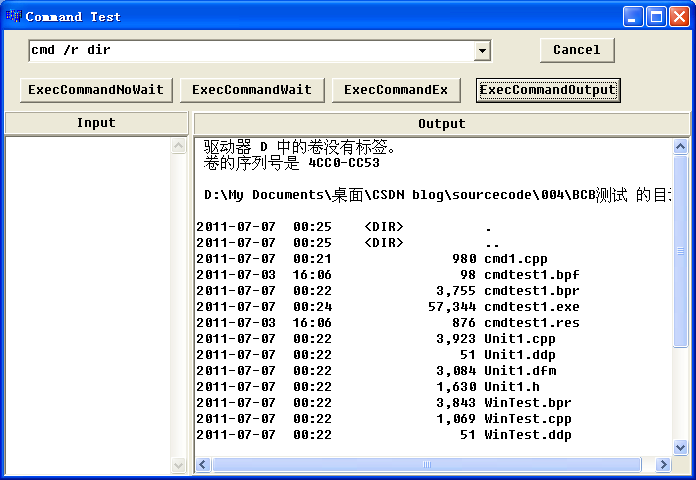参考:
http://qiusuoge.com/11496.html
http://www.cnblogs.com/BoyXiao/archive/2011/01/01/1923828.html
stdin是标准输入,stdout是标准输出,stderr是标准错误输出。大多数的命令行程序从stdin输入,输出到stdout或 stderr,有时我们需要重定向stdout,stderr,stdin。比如:将输出写入文件,又或者我们要将命令行程序输出结果显示到 Windows对话框中。
相关阅读
在Windows编程中,重定向需要用到管道(Pipe)的概念。管道是一种用于在进程间共享数据的机制。一个管道类似于一个管子的两端,一端是写入的,一端是读出的。由一个进程从写入端写入、另一个进程从读出端读出,从而实现通信,就向一个“管道”一样。
重定向的原理是:
首先声明两个概念:主程序(重定向的操纵者)、子进程(被重定向的子进程)
如果要重定位stdout的话,先生成一个管道, 管道的写入端交给子进程去写,主程序从管道的读出端读数据,然后可以把数据写成文件、显示等等。重定向stderr和stdout是相同的。
同理,要重定向stdin的话,生成一个管道, 管道的写入端由主程序写,子进程从管道的读出端读数据。
其中需要用到几个Windows API : CreatePipe, DuplicateHandle, CreateProcess, ReadFile, WriteFile 等,函数详解可参见MSDN.
一、编程实现原理 ( C语言)
view plaincopy to clipboard
#include <windows.h>
//定义句柄: 构成stdin管道的两端句柄
HANDLE hStdInRead; //子进程用的stdin的读入端
HANDLE hStdInWrite; //主程序用的stdin的读入端
//定义句柄: 构成stdout管道的两端句柄
HANDLE hStdOutRead; ///主程序用的stdout的读入端
HANDLE hStdOutWrite; ///子进程用的stdout的写入端
//定义句柄: 构成stderr管道的句柄,由于stderr一般等于stdout,我们没有定义hStdErrRead,直接用hStdOutRead即可
HANDLE hStdErrWrite; ///子进程用的stderr的写入端
//定义一个用于产生子进程的STARTUPINFO结构体 (定义见CreateProcess,函数说明)
STARTUPINFO siStartInfo;
//定义一个用于产生子进程的PROCESS_INFORMATION结构体 (定义见CreateProcess,函数说明)
PROCESS_INFORMATION piProcInfo;
//产生一个用于stdin的管道,得到两个HANDLE: hStdInRead用于子进程读出数据,hStdInWrite用于主程序写入数据
//其中saAttr是一个STARTUPINFO结构体,定义见CreatePipe函数说明
if (!CreatePipe(&hStdInRead, &hStdInWrite,&saAttr, 0))
return;
//产生一个用于stdout的管道,得到两个HANDLE: hStdInRead用于主程序读出数据,hStdInWrite用于子程序写入数据
if (!CreatePipe(&hStdOutRead, &hStdOutWrite,&saAttr, 0))
return;
//由于stderr一般就是stdout, 直接复制句柄hStdOutWrite,得到 hStdErrWrite
if (!DuplicateHandle(GetCurrentProcess(), hStdOutWrite,
GetCurrentProcess(), &hStdErrWrite, 0, TRUE,
DUPLICATE_SAME_ACCESS))
return;
//对STARTUPINFO结构体赋值,对stdin,stdout,stderr的Handle设置为刚才得到的管道HANDLE
ZeroMemory( &siStartInfo, sizeof(STARTUPINFO) );
siStartInfo.cb = sizeof(STARTUPINFO);
siStartInfo.dwFlags |= STARTF_USESHOWWINDOW;
siStartInfo.dwFlags |= STARTF_USESTDHANDLES;
siStartInfo.hStdOutput = hStdOutWrite; //意思是:子进程的stdout输出到hStdOutWrite
siStartInfo.hStdError = hStdErrWrite; //意思是:子进程的stderr输出到hStdErrWrite
siStartInfo.hStdInput = hStdInRead;
// 产生子进程,具体参数说明见CreateProcess函数
bSuccess = CreateProcess(NULL,
CommandLine, // 子进程的命令行
NULL, // process security attributes
NULL, // primary thread security attributes
TRUE, // handles are inherited
0, // creation flags
NULL, // use parent's environment
NULL, // use parent's current directory
&siStartInfo, // STARTUPINFO pointer
&piProcInfo); // receives PROCESS_INFORMATION
//如果失败,退出
if (!bSuccess ) return;
//然后,就可以读写管道了
//写入stdin,具体代码在一个WriteToPipe函数中
WriteToPipe();
//不断子检测进程有否结束
while (GetExitCodeProcess(piProcInfo.hProcess,&process_exit_code))
{
//读stdout,stderr
ReadFromPipe();
//如果子进程结束,退出循环
if (process_exit_code!=STILL_ACTIVE) break;
}
[html] view plaincopy
#include <windows.h>
//定义句柄: 构成stdin管道的两端句柄
HANDLE hStdInRead; //子进程用的stdin的读入端
HANDLE hStdInWrite; //主程序用的stdin的读入端
//定义句柄: 构成stdout管道的两端句柄
HANDLE hStdOutRead; ///主程序用的stdout的读入端
HANDLE hStdOutWrite; ///子进程用的stdout的写入端
//定义句柄: 构成stderr管道的句柄,由于stderr一般等于stdout,我们没有定义hStdErrRead,直接用hStdOutRead即可
HANDLE hStdErrWrite; ///子进程用的stderr的写入端
//定义一个用于产生子进程的STARTUPINFO结构体 (定义见CreateProcess,函数说明)
STARTUPINFO siStartInfo;
//定义一个用于产生子进程的PROCESS_INFORMATION结构体 (定义见CreateProcess,函数说明)
PROCESS_INFORMATION piProcInfo;
//产生一个用于stdin的管道,得到两个HANDLE: hStdInRead用于子进程读出数据,hStdInWrite用于主程序写入数据
//其中saAttr是一个STARTUPINFO结构体,定义见CreatePipe函数说明
if (!CreatePipe(&hStdInRead, &hStdInWrite,&saAttr, 0))
return;
//产生一个用于stdout的管道,得到两个HANDLE: hStdInRead用于主程序读出数据,hStdInWrite用于子程序写入数据
if (!CreatePipe(&hStdOutRead, &hStdOutWrite,&saAttr, 0))
return;
//由于stderr一般就是stdout, 直接复制句柄hStdOutWrite,得到 hStdErrWrite
if (!DuplicateHandle(GetCurrentProcess(), hStdOutWrite,
GetCurrentProcess(), &hStdErrWrite, 0, TRUE,
DUPLICATE_SAME_ACCESS))
return;
//对STARTUPINFO结构体赋值,对stdin,stdout,stderr的Handle设置为刚才得到的管道HANDLE
ZeroMemory( &siStartInfo, sizeof(STARTUPINFO) );
siStartInfo.cb = sizeof(STARTUPINFO);
siStartInfo.dwFlags |= STARTF_USESHOWWINDOW;
siStartInfo.dwFlags |= STARTF_USESTDHANDLES;
siStartInfo.hStdOutput = hStdOutWrite; //意思是:子进程的stdout输出到hStdOutWrite
siStartInfo.hStdError = hStdErrWrite; //意思是:子进程的stderr输出到hStdErrWrite
siStartInfo.hStdInput = hStdInRead;
// 产生子进程,具体参数说明见CreateProcess函数
bSuccess = CreateProcess(NULL,
CommandLine, // 子进程的命令行
NULL, // process security attributes
NULL, // primary thread security attributes
TRUE, // handles are inherited
0, // creation flags
NULL, // use parent's environment
NULL, // use parent's current directory
&siStartInfo, // STARTUPINFO pointer
&piProcInfo); // receives PROCESS_INFORMATION
//如果失败,退出
if (!bSuccess ) return;
//然后,就可以读写管道了
//写入stdin,具体代码在一个WriteToPipe函数中
WriteToPipe();
//不断子检测进程有否结束
while (GetExitCodeProcess(piProcInfo.hProcess,&process_exit_code))
{
//读stdout,stderr
ReadFromPipe();
//如果子进程结束,退出循环
if (process_exit_code!=STILL_ACTIVE) break;
}
具体看一下WriteToPipe(), ReadFromPipe函数:
view plaincopy to clipboard
//写入stdin
BOOL WriteToPipe()
{
DWORD dwWritten;
BOOL bSuccess = FALSE;
//用WriteFile,从hStdInWrite写入数据,数据在in_buffer中,长度为dwSize
bSuccess = WriteFile( hStdInWrite, in_buffer, dwSize, &dwWritten, NULL);
return bSuccess;
}
[html] view plaincopy
//写入stdin
BOOL WriteToPipe()
{
DWORD dwWritten;
BOOL bSuccess = FALSE;
//用WriteFile,从hStdInWrite写入数据,数据在in_buffer中,长度为dwSize
bSuccess = WriteFile( hStdInWrite, in_buffer, dwSize, &dwWritten, NULL);
return bSuccess;
}
view plaincopy to clipboard
// 读出stdout
BOOL ReadFromPipe()
{
char out_buffer[4096];
DWORD dwRead;
BOOL bSuccess = FALSE;
//用WriteFile,从hStdOutRead读出子进程stdout输出的数据,数据结果在out_buffer中,长度为dwRead
bSuccess = ReadFile( hStdOutRead, out_buffer, BUFSIZE, &dwRead, NULL);
if ((bSuccess) && (dwRead!=0)) //如果成功了,且长度>0
{
// 此处加入你自己的代码
// 比如:将数据写入文件或显示到窗口中
}
return bSuccess;
}
[html] view plaincopy
// 读出stdout
BOOL ReadFromPipe()
{
char out_buffer[4096];
DWORD dwRead;
BOOL bSuccess = FALSE;
//用WriteFile,从hStdOutRead读出子进程stdout输出的数据,数据结果在out_buffer中,长度为dwRead
bSuccess = ReadFile( hStdOutRead, out_buffer, BUFSIZE, &dwRead, NULL);
if ((bSuccess) && (dwRead!=0)) //如果成功了,且长度>0
{
// 此处加入你自己的代码
// 比如:将数据写入文件或显示到窗口中
}
return bSuccess;
}
OK,到此原理写完了。为简化说明原理,上述代码省略了出错处理、结束处理(如:CloseHandle等),具体可以参见我的源码。
二、封装、实用的代码
上述过程有些麻烦,实际使用中,我封装成几个函数:
首先定义三个回调函数 (就是函数指针类型)
//当stdin输入时,调用此函数。将要写的数据写入buf中,*p_size写为数据长度即可。
typedef void FuncIn(char *buf,int *p_size);
//当stdout,stderr输出时,调用此函数。可读取的数据在buf中,数据长度为size。
typedef void FuncOut(char *buf,int size);
//当子进程持续过程中,周期性调用此函数,设置p_abort可中断子进程。
typedef void FuncProcessing(int *p_abort);
然后定义了四个函数
//执行一个命令行,重定向stdin, stdout,stderr。
//OnStdOut是回调函数指针,当有输出时,OnStdOut被调用。
//OnStdIn是回调函数指针,当输入时,OnStdIn被调用。
int ExecCommandEx(char *szCommandLine,char *CurrentDirectory,char *Environment,unsigned short ShowWindow,
FuncOut *OnStdOut,FuncProcessing *OnProcessing,FuncIn *OnStdIn);
//执行一个命令行,重定向stdout,stderr。
//OnLineOut是回调函数指针,当有一行输出时,OnLineOut被调用。
int ExecCommandOutput(char *szCommandLine,char *Environment,unsigned short ShowWindow,
FuncOut *OnLineOut,FuncProcessing *OnProcessing);
//执行一个命令行,等待子进程结束,返回子进程的程序退出代码。不处理重定向。
int ExecCommandWait(char *szCommandLine,unsigned short ShowWindow,FuncProcessing *OnProcessing);
//执行一个命令行,不等待子进程结束,即返回。不处理重定向。功能相当于 Windows API WinExec.
int ExecCommandNoWait(char *szCommandLine,unsigned short ShowWindow);
还定义了一个存储数据的EXEC_INFO结构体及操作它的函数。
全部代码为C语言,在JExecution.c, JExecution.h两个文件中。只用到了Windows API,没有用MFC及其他库。
三、使用方法
有了JExecution.c,使用就很方便了。比如:
view plaincopy to clipboard
#include <stdio.h>
#include <windows.h>
#include "JExecution.h"
//定义一个处理输出的回调函数
void OnLineOut(char *buf,int size)
{
printf("%s
", buf);
}
int main(int argc, char* argv[])
{
int n;
char *command;
command = "cmd.exe /r dir/w "; //这个命令的意思就是调用DOS,执行dir命令,显示当前目前下的文件
n=ExecCommandOutput(command,NULL,SW_HIDE,OnLineOut,NULL);
printf("<Return:>%d",n);
}
[html] view plaincopy
#include <stdio.h>
#include <windows.h>
#include "JExecution.h"
//定义一个处理输出的回调函数
void OnLineOut(char *buf,int size)
{
printf("%s
", buf);
}
int main(int argc, char* argv[])
{
int n;
char *command;
command = "cmd.exe /r dir/w "; //这个命令的意思就是调用DOS,执行dir命令,显示当前目前下的文件
n=ExecCommandOutput(command,NULL,SW_HIDE,OnLineOut,NULL);
printf("<Return:>%d",n);
}
我用C++ Builder 6写了一个示范程序。示范将stdout重定向,输出到窗口中。

四、小结
Windows管道虽然有些麻烦,却可以产生好的效果。
比如:我们常用的IDE就是把调用命令行的编译程序,将其stdout重定向,将结果信息显示在窗口中。
又比如,我们把上述的程序改一下,把dir命令的结果通过网络发送出去,嗯,Hacker.